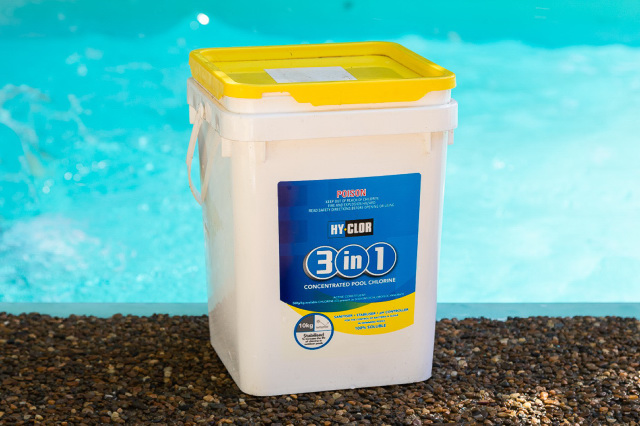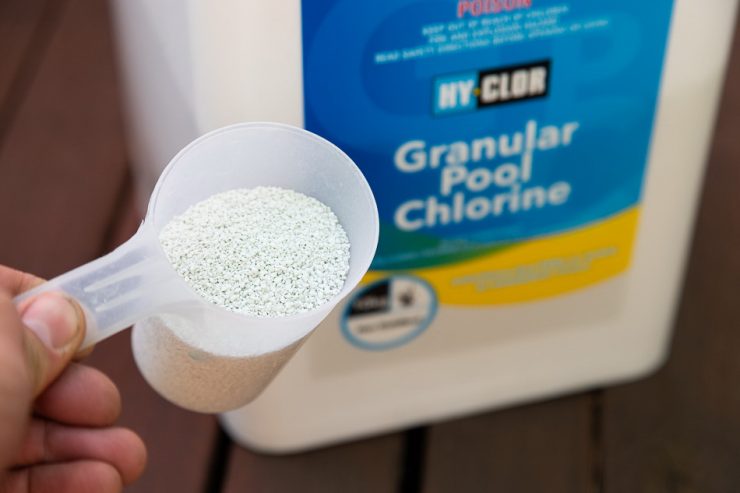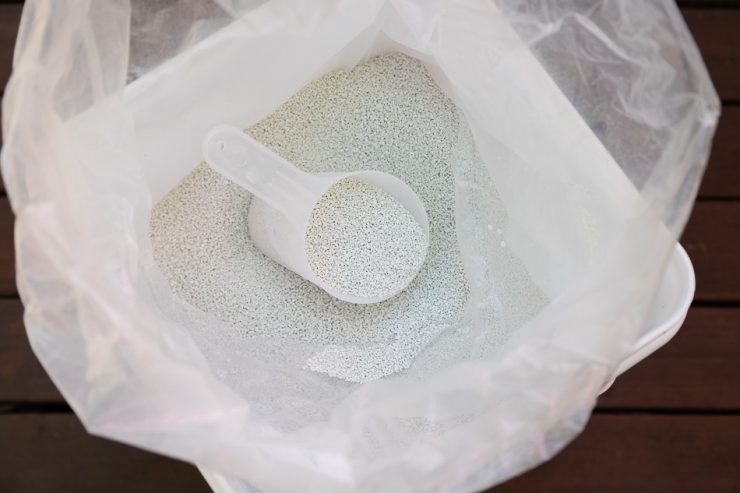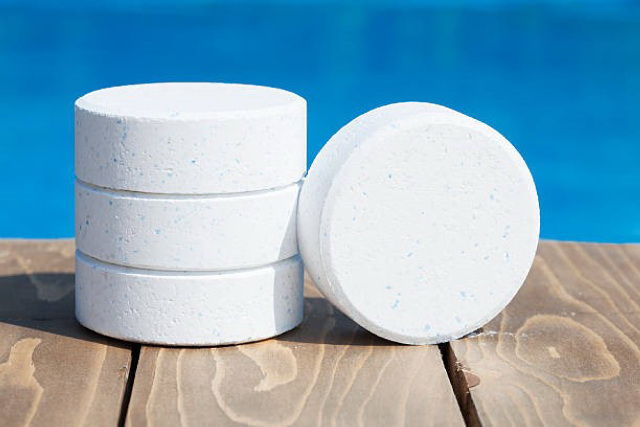The question many pool owners are wondering about is whether you can add chlorine to a saltwater pool?
Adding chlorine to a saltwater pool is recommended if the chlorine levels are below 1 ppm. Adding chlorine will quickly increase the chlorine levels to the safe range. It’s also acceptable to add chlorine to shock your saltwater pool.
There’s a bit more to it than that though. Let’s find out why you would add chlorine, when to add it and how much to add to your saltwater pool.

Article Contents
A Saltwater Pool Is a Chlorine Pool
In order to fully understand when, why, and how chlorine is added to a saltwater pool, it is important to understand what a saltwater pool is.
A saltwater pool is essentially a chlorine pool. Let me explain.
Chlorine is manually added to a traditional pool to kill germs and clear the water. Chlorine is added, usually by hand, in the form of liquid, powder, granules, or tablets.
The only difference between a saltwater pool and a chlorine pool is the delivery method of the chlorine. And the fact you add salt to the water. This is why it is called a saltwater pool.
A saltwater pool uses a salt-chlorine generator (SWG or chlorinator) to convert the salt in the water into chlorine. So, in essence, instead of manually adding chlorine to the water, the salt chlorine generator creates it.
Can You Add Chlorine to a Saltwater Pool?
Chlorine can and should be added to a saltwater pool if necessary. Since a saltwater pool uses chlorine for disinfection, adding additional chlorine is safe in a saltwater pool.
The aim is to keep chlorine levels between 1 and 5 ppm. If your chlorine levels are low, by all means, add some additional chlorine. However, if you need to continually add chlorine to your saltwater pool it may indicate several things:
- The water is out of balance (i.e. pH, stabilizer, etc.)
- The chlorine generator needs a higher power setting
- The chlorine generator has stopped making chlorine
- The salt cell needs cleaning
- The salt cell is worn and on the way out
- The pool salt levels are low
If you need more salt for your pool, take a look at the best salts available here: Ideal Pool Salt Options for a Saltwater Pool

Why Put Chlorine in a Saltwater Pool?
Now you know there’s already chlorine in the water of your saltwater pool. Why would you want to add more chlorine to it?
The process of converting salt water to chlorine is fairly slow. And at times, the saltwater chlorine generator may not produce chlorine fast enough.
You may need to add additional chlorine:
- After a heavy bather load
- After rain or lots of wind
- If you have algae
- If the pool water is cloudy
- To shock your pool
For example, if you’ve recently had a party and there were more swimmers in the pool than on any normal day you may choose to add additional chlorine to increase the chlorine levels quickly. Bathers leave a lot of byproducts behind and this needs to be sanitized.
A heavy downpour of rain can also be a good reason to add additional chlorine to a saltwater pool. You may want to help the pool along by adding chlorine to the water.
Pool owners can add more chlorine to their pool by adding chlorine tablets, chlorine granules, sodium hypochlorite (liquid chlorine or bleach), or calcium hypochlorite.
Do You Need to Add Chlorine to a Saltwater Pool
It is not necessary to add chlorine to a saltwater pool if the water is balanced correctly and the saltwater chlorine generator is set up optimally.
The saltwater generator should supply all the chlorine necessary to your pool. You can check this by regularly testing your pool water with a test kit. Chlorine should be maintained at 1-5 ppm. You’ll also want to make sure the stabilizer is 30-70 ppm, pH is 7.2-7.8 and alkalinity is 80-140 ppm.
If these levels are not correct, the chlorine will not work properly.
The most accurate test kits are DPD Test Kits. Or drop test kits. And your water should be tested 2-3 times per week.
- For saltwater pools
- Extremely accurate
- Tests 7 things including salt, pH, chlorine, cyanuric acid
How Much Chlorine Should You Put in a Saltwater Pool
The amount of chlorine you add to your saltwater pool will depend on the type of chlorine used. In any case, the aim is to maintain chlorine levels at 1-5 ppm.
This chart shows how much chlorine to add to your saltwater pool to increase chlorine levels by 1 ppm for every 10,000 gals of pool water.
| Chlorine Type | Amount |
| Liquid Chlorine (12% strength) | 10 fl oz (283 g) |
| Bleach (6% strength) | 21 fl oz (595 g) |
| Trichlor | 1.5 oz (43 g) |
| Dichlor | 2.4 oz (68 g) |
| Cal-hypo (73% strength) | 1.8 oz (51 g) |
Keep in mind that the chlorine strength does change from manufacturer to manufacturer. Check the instructions before adding.
What Types of Chlorine Are OK for Saltwater Pools
There are two classes of chlorine, stabilized or unstabilized.
Use stabilized chlorine if your stabilizer (aka cyanuric acid) levels are below 30 ppm. Otherwise, select chlorine that is not stabilized.
Chlorine comes in many different forms and types. These are ideal for traditional pools but can also be used in saltwater pools:
Granules
This type of chlorine raises the chlorine levels quickly and dissolves very quickly. It’s added to a bucket of water before being poured into a pool. This type of chlorine can be used in a saltwater pool as it will quickly raise the chlorine level of the pool. It comes as trichlor, dichlor, and cal-hypo. Cal-hypo isn’t the best choice for saltwater pools.

Tablets
Chlorine tablets have a concentration of chlorine between 60 and 90%. They are administered through floating dispensers or automatic chemical feeders. These can also be used in a saltwater pool to provide an additional slowly administered chlorine boost.
Chlorine tablets come as trichlor and dichlor (both stabilized) and cal-hypo (unstabilized).

Trichlor
It stands for Trichloro-S-Triazinetrione. It is a concentrated sanitizer that contains 90% chlorine and cyanuric acid. This is stabilized chlorine. This product has a long shelf life and will not cloud the pool.
- 3" chlorinating trichlor tablets
- Contains stabilizer to protect against sunlight
- Prevents algae and kills harmful bacteria
Dichlor
This product cleans and sanitizes pools through a chemical reaction. The dichlor transforms into hydrochloric acid when it is poured into the pool. It is, in fact, safe to use in saltwater pools to super chlorinate the pool.
It is a stabilized type of chlorine and comes in tablet and powder or granular form. It’s a good choice for saltwater pools.
- Dichlor chlorine with stabilizer to resist UV light
- Dissolves quickly & kills algae & bacteria
- Safe for pools & spas (salt & regular chlorine pools)
Liquid Chlorine or Bleach
Also known as sodium hypochlorite or household bleach. This type of chlorine is most often used in commercial swimming pools and home swimming pools. You can use liquid chlorine in a saltwater pool.
It is both a safe and a smart choice. It is unstabilized and doesn’t leave byproducts behind.
- Commercial-strength liquid chlorine (aka bleach or sodium hypochlorite)
- Rapidly eliminates algae, bacteria, and other contaminants, ensuring crystal-clear water
- Safe for pools & spas (saltwater & chlorine systems)
- Use as a shock or regular sanitizer
What Chlorines to Avoid in Saltwater Pools
Most chlorines are OK for a saltwater pool. But there is one you should avoid. That’s cal-hypo. Don’t panic if you’ve already added it, just don’t use it over the long term.
Calcium hypochlorite is unstabilized and contains calcium. It’s best not to add this chlorine to a saltwater pool as it will increase calcium levels. Saltwater pools generally already have enough calcium and do not benefit from adding more.
How to Increase Free Chlorine Levels in a Saltwater Pool
1. Use the “Super-Chlorinate” Setting
The “super-chlorinate” setting on your saltwater generator (SWG) increases the amount of chlorine the saltwater generator produces (SWG). This essentially puts the SWG into overdrive for a short period of time boosting the free chlorine levels.
Even with this though, it will not be enough chlorine to shock your pool. Shocking is adding a large dose of chlorine which is often used to kill algae.
Keep in mind though, that while super-chlorinating is necessary from time to time, it should not be done too often as it will wear out the salt cell faster.
2. Increase the Time the Saltwater Generator Runs For
For a slight increase in the chlorine level of your salt pool, increase the time the saltwater generator runs.
For most pool owners, you’ll need to adjust the pool pump timer and also the saltwater generator control panel. The pool pump needs to be ON for the saltwater generator to run.
On average, your saltwater generator should be running 8-12 hours per day. It’s counter-productive to run the SWG over 14-16 hours per day as it will increase the wear on the salt cell.
3. Increase the Saltwater Generator Power Level
The third option to increase the free chlorine in your saltwater pool is to simply turn up the power level on the saltwater generator. Most saltwater generators display the power level as a percentage.
The percentage is the amount of chlorine production. For example, a 50% power level indicates that the SWG is producing 50% of the maximum amount of chlorine.
To increase the chlorine level, simply locate the power control on the saltwater chlorine generator control panel and increase it. Most pool owners set their SWG at 40-70% power. You don’t want to run it at 100% power as this will wear out the salt cell faster. It’s actually best to use an oversized or more powerful salt cell and run less power percentage. It works out better for your wallet this way.
4. Manually Add Chlorine to Your Pool
The final method is to manually add chlorine to the pool water. You can essentially use any of the available chlorines including:
- Trichlor
- Dichlor
- Liquid Chlorine or Bleach
- Cal-hypo (not ideal for saltwater pools as it increases calcium)
To do this, simply follow the manufacturer’s instructions and add the chlorine to the water.
This is the fastest way to increase the free chlorine in a saltwater pool.
Too Much Chlorine in Saltwater Pool
Do not be concerned about adding too much chlorine to your saltwater pool.
What should you do if you have added too much chlorine to your saltwater pool?
Turn off the saltwater chlorine generator for a day or two and leave the pool uncovered. i.e. take off the swimming pool cover. The chlorine will naturally dissipate within a day or two. Don’t swim in the pool if the chlorine level is above 5 ppm though.
You’ll be able to swim again when it’s back under 5 ppm. Use a test kit to determine the chlorine levels.






Can I use regular shock to open my salt water pool or do I need a shock treatment for salt water pools. They told me not to use regular shock treatment that it can ruin my pool. Plus it costs more for shock treatment for salt water.
The short answer is you can use regular shock in a saltwater pool. Shock is just chlorine. A saltwater pool is a chlorine pool except it gets it’s chlorine through a saltwater chlorine generator. Here’s a bit more info:
1. Regular Shock Treatment: Regular shock treatments are usually calcium hypochlorite (cal hypo) and they can be used in salt water pools, but it’s important to monitor calcium levels. Over time, using cal hypo can raise calcium levels, potentially leading to scaling and cloudiness.
2. Calcium Levels: Salt water pools often have higher calcium levels, and adding cal hypo can exacerbate this, leading to maintenance issues.
3. Liquid Chlorine: Liquid chlorine (sodium hypochlorite) is a safer alternative for shocking salt water pools. It effectively sanitizes the pool without increasing calcium levels, making it a better option to maintain water balance and prevent potential issues.
So, using regular shock treatment is fine as long as you keep an eye on calcium levels. If you want to avoid any potential problems, liquid chlorine is a perfectly safe and effective option.
Do you add granular, liquid or tablet chlorine while the salt generator is running ?
Will it damage the cell if you do ?
It’s OK to add granular or liquid chlorine to your saltwater pool while the salt generator is running. A salt pool has the same amount of chlorine in it as a regular chlorine pool. The saltwater generator converts the salt water in the pool to chlorine.